chapter02 - 03 作业
1、分别用cat \tac\nl三个命令查看文件/etc/ssh/sshd_config文件中的内容,并用自己的话总计出这三个文档操作命令的不同之处?
cat命令可同时显示多个文件的内容
tac倒着显示文件内容
nl命令文件加行号,对空白行不加行号
2、分别用more和less查看/etc/ssh/sshd_config里面的内容,请用总结more和less两个命令的相同和不同之处?
more命令是全屏方式分页显示文件内容
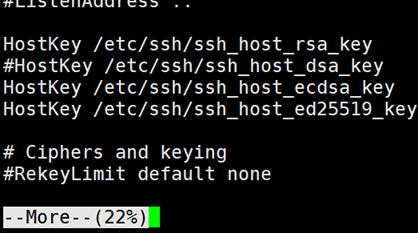


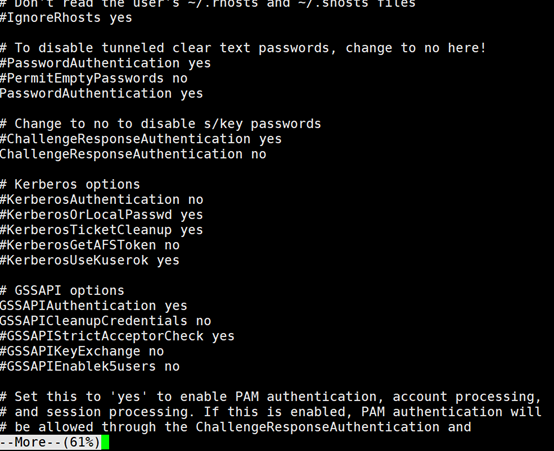
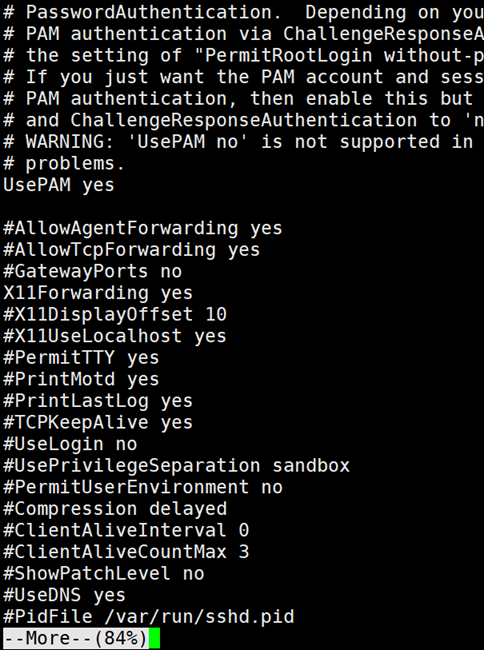
less命令功能多可以按/查找内容,按pguf、pgdn键上下翻页
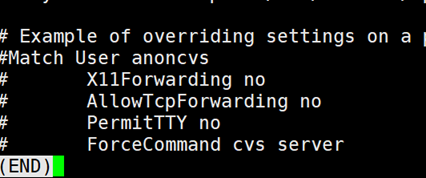
3、将/etc/passwd文件中的前20行重定向保存到/root下改名为20_pass.txt,将/etc/passwd文件中的后15行重定向保存到/root下改名为:pass_15.txt
[root@localhost /]# head -20 /etc/passwd > /root/20_pass.txt
[root@localhost /]# ls /root
20_pass.txt anaconda-ks.cfg

[root@localhost /]# tail -15 /etc/passwd > /root/pass_15.txt

4、请用一个命令统计/etc/hosts文件包含有多少行?多少字节?多少单词数?
[root@localhost /]# wc /etc/hosts
2 10 158 /etc/hosts

包含两行,158字节,十个单词数。
5、练习使用grep和egrep
5.1.通过grep管道工具过滤出ifconfig命令显示信息中的IP字段?
[root@localhost ~]# ifconfig | grep "inet"
inet 192.168.100.199 netmask 255.255.255.0 broadcast 192.168.100.255
inet6 fe80::36ec:28ae:8711:ba74 prefixlen 64 scopeid 0x20<link>
inet 127.0.0.1 netmask 255.0.0.0
inet6 ::1 prefixlen 128 scopeid 0x10<host>

5.2.将/etc/passwd文件中的前20行重定向保存到/root下名称为pass?
[root@localhost ~]# head -20 /etc/passwd > /root/pass
[root@localhost ~]# ls
20_pass.txt anaconda-ks.cfg pass pass_15.txt
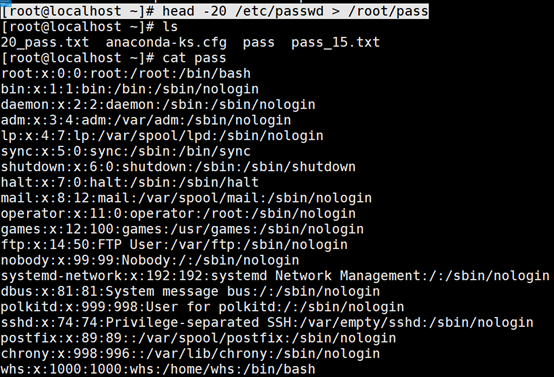
5.3.过滤/etc/passwd文件中含有/sbin/nologin 的行并统计行数?
[root@localhost ~]# grep "/sbin/nologin" /etc/passwd |wc -l

5.4 过滤/etc/passwd文件中以sh结尾的行,及以 root开头的行,不显示包含login的行?
[root@localhost ~]# grep "sh$" /etc/passwd | grep "^root" | grep -v "login"

5.5 分别用grep和egrep过滤出/etc/ssh/sshd_config文件中不包含“#”开头和空白的行?
[root@localhost ~]# grep -v "^#" /etc/ssh/sshd_config |grep -v "^$"

[root@localhost ~]# egrep -v "^#|^$" /etc/ssh/sshd_config
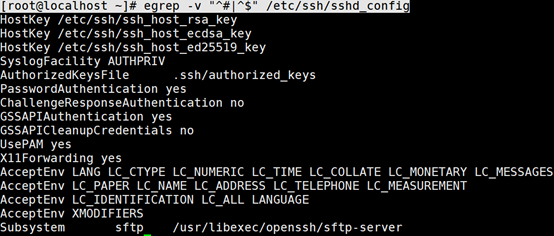
6.1 通过tar命令将/etc/passwd文件打包压缩成/root/file.tar.gz
[root@localhost /]# tar -zcf /root/file.tar.gz /etc/passwd

6.2通过tar命令将/etc/passwd文件打包压缩成/root/file.tar.bz2
[root@localhost /]# tar -jcf /root/file.tar.bz2 /etc/passwd

6.3创建空文件夹/web/test1,并将file.tar.bz2 解包并释放到/web/test1目录下?
[root@localhost /]# mkdir -p /web/test1 | tar -xvjf /root/file.tar.bz2 -C /web/test1

7.1 通过vi编辑/web/test1/passwd文件将文件里为root单词全部替换成benet。
输入命令:vi /web/test1/passwd 进入文档编辑,在末行模式输入
:% s/root/benet/g
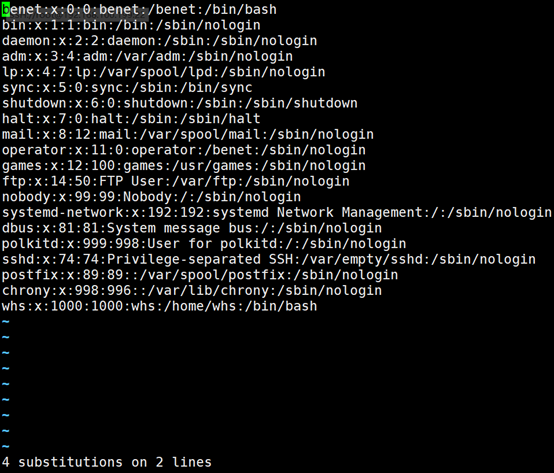
7.2 通过vi编辑 删除pass文件第1、5、10行。
在末行模式输入“1”定位到第一行,按两下dd删除第一行、
在末行模式输入“5”定位到第五行,按两下dd删除第五行、
在末行模式输入“10”定位到第五行,按两下dd删除第十行、
7.3 在vi中显示pass文件行号复制文件2 3 4行粘贴到以lp开头的行下。
在末行模式输入“2”快速定位到第二行,,按3yy进行复制2 3 4 行,找到lp所在行按p粘贴
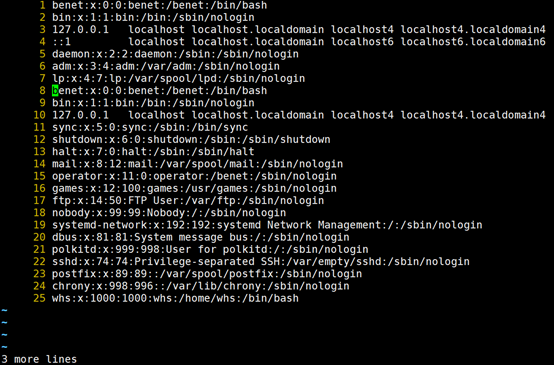
7.4 通过vi编辑 查找文件内包含mail var等字符串,并记录所在行号。
在末行模式输入/mail 按Enter查找mail在第十四行
在末行模式输入/var 按Enter查找var在第十七行
7.5 通过vi编辑 快速跳转到文件的第二行,通过r 读取 /etc/hosts 文件的内容到第二行下。
在末行模式输入2回车跳转到第二行,然后在末行模式输入
:r /etc/hosts

7.6将更改后的文件使用vim另存为/root/new_pass。
在末行模式输入:w /root/new_pass 按Enter


7.7将new_pass文件压缩成gz格式并改名为npass.gz文件。
[root@localhost /]# gzip /root/new_pass | mv /root/new_pass.gz /root/npass.gz

8统计/dev 目录下的文件数量。
[root@localhost /]# ls -l /dev | wc -l

9.1在/boot下查找文件名以vmlinuz开头的文件?
[root@localhost /]# find /boot/ -name "vmlinuz*"

9.2在/boot下查找文件大小大于3M 小于 20M 的文件
[root@localhost /]# find /boot -size +3M -a -size -20M

10 请详细写出构建本地yum仓库的步骤?并在每行命令后面用自己的话做上中文注释?
[root@localhost ~]# umount /dev/sr0 //卸载光盘
umount: /dev/sr0:未挂载
[root@localhost ~]# mount /dev/sr0 /media/ //挂载光盘
mount: /dev/sr0 写保护,将以只读方式挂载
[root@localhost ~]# ls /media/ //查看media
CentOS_BuildTag EULA images LiveOS repodata RPM-GPG-KEY-CentOS-Testing-7
EFI GPL isolinux Packages RPM-GPG-KEY-CentOS-7 TRANS.TBL
[root@localhost ~]# cd /etc/yum.r* //构建本地yum仓库
[root@localhost yum.repos.d]# mkdir a
[root@localhost yum.repos.d]# mv C* a
[root@localhost yum.repos.d]# vi ./local.repo //创建本地yum仓库文档
[cdrom] //仓库名称
name=cdrom
baseurl=file:///media //指定rpm包的位置
enabled=1 //启用本地yum仓库
gpgcheck=0 //禁用gpg校验
[root@localhost yum.repos.d]# yum -y clean all //清除yum缓存
已加载插件:fastestmirror
正在清理软件源: cdrom
Cleaning up everything
Maybe you want: rm -rf /var/cache/yum, to also free up space taken by orphaned data from disabled or removed repos
Cleaning up list of fastest mirrors
[root@localhost yum.repos.d]# yum makecache //重建yum缓存
已加载插件:fastestmirror
Determining fastest mirrors
cdrom | 3.6 kB 00:00
(1/4): cdrom/group_gz | 166 kB 00:00
(2/4): cdrom/filelists_db | 3.1 MB 00:00
(3/4): cdrom/primary_db | 3.1 MB 00:00
(4/4): cdrom/other_db | 1.3 MB 00:00
元数据缓存已建立
11、用yum命令安装vsftpd,查询安装情况,最后卸载vsftpd,并再次查询卸载情况?
[root@localhost yum.repos.d]# yum -y install vsftpd //安装vsftpd
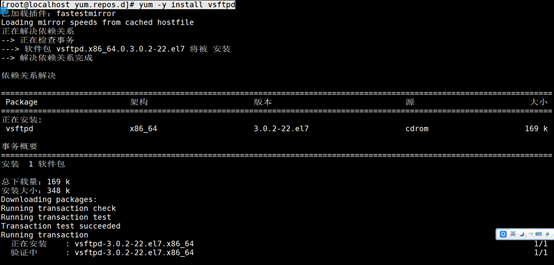
[root@localhost yum.repos.d]# rpm -q vsftpd //查询安装

[root@localhost yum.repos.d]# rpm -e vsftpd //卸载vsftpd

12、用rpm命令安装vsftpd,查询安装情况,最后卸载vsftpd,并再次查询卸载情况?
[root@localhost Packages]# rpm -ivh vsftpd-3.0.2-22.el7.x86_64.rpm

[root@localhost Packages]# rpm -q vsftpd //查询安装

[root@localhost yum.repos.d]# rpm -e vsftpd //卸载vsftpd
